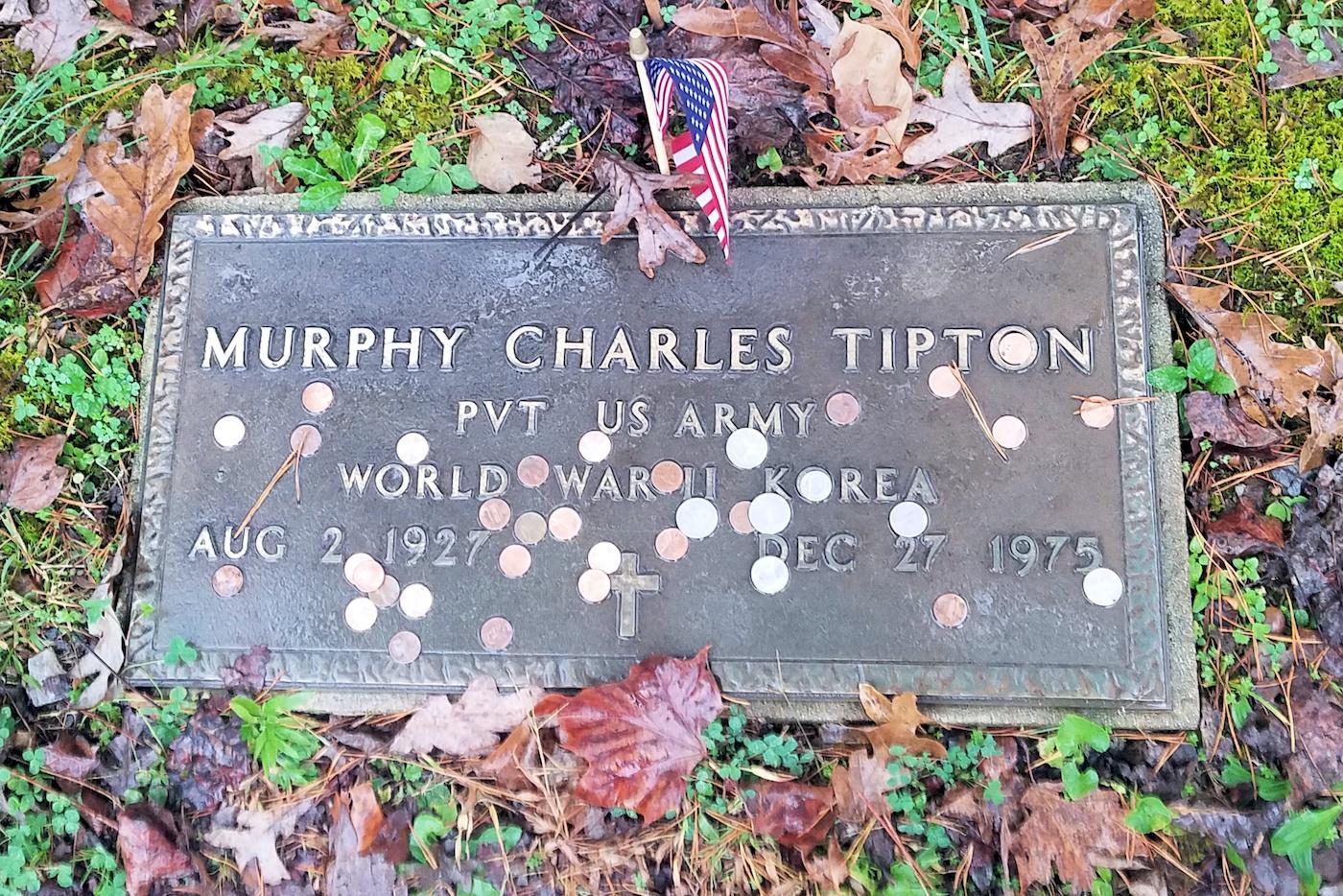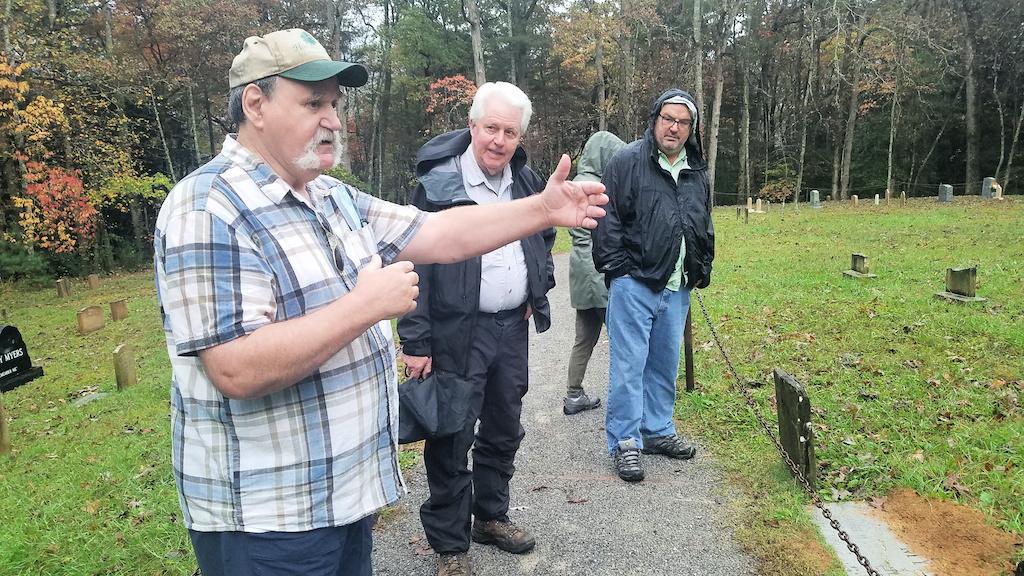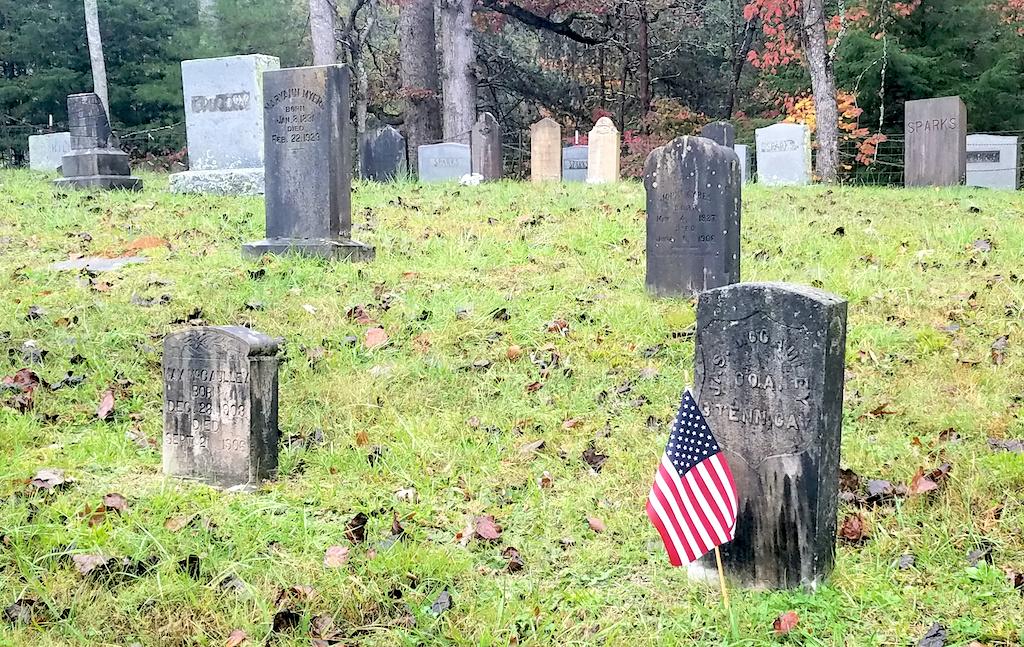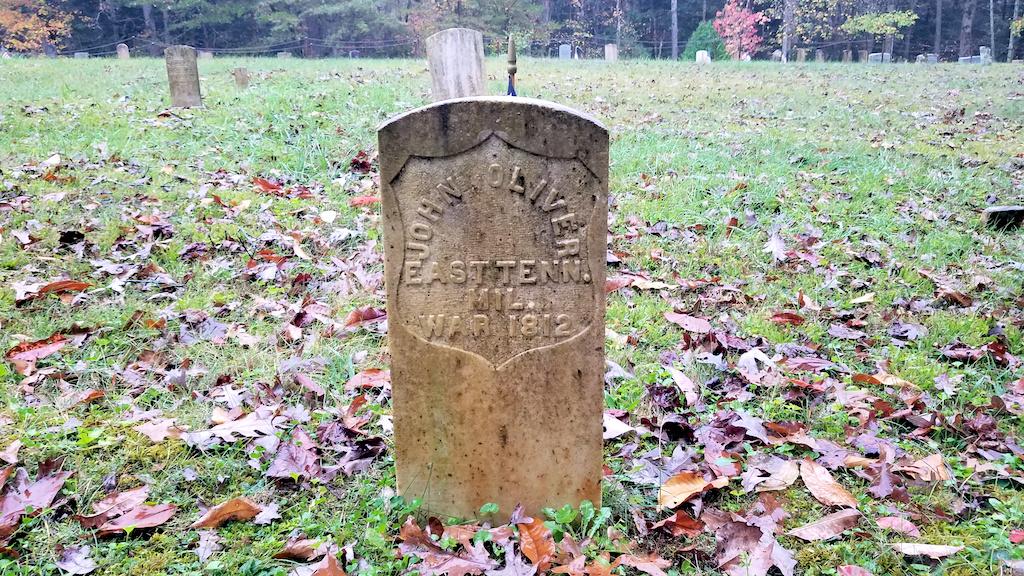
Within Great Smoky Mountains National Park there are more than 150 graves of military veterans/Kim O'Connell
The fog hangs around the neck of the mountains like a shawl. It’s raining hard enough to knock red and yellow leaves off the trees, hastening autumn along to its bare-branched conclusion. Despite the damp, I’m standing in the graveyard of the old Methodist Church in Cades Cove, the verdant, mountain-ringed valley that is one of the most popular destinations in Great Smoky Mountains National Park. My three companions—Joe Emert, Frank March, and Roderick Law—are telling me about the people buried here with affection and familiarity, like people talk about their grandparents.
The presence of humans is felt throughout the Cove, as locals call it. This fertile landscape was home to hundreds of mountain families before the park was created, and to indigenous people long before that. Today, the park interprets this history through log homesteads, modest churches, and a working mill that are preserved in the Cove. Families buried their dead in the small Cove churchyards for years, creating a mosaic of headstones that have grown stained and faded with time.
For Emert, who serves on the National Park System Advisory Board and the board of the Great Smoky Mountains Institute at Tremont, a chance conversation led him to discover that the park did not maintain a list of all the U.S. veterans buried within its boundaries, so he set out to change that.

Roderick Law, Frank March, and Joe Emert (l to r) and other volunteers search the park's landscape for unknown military graves/Kim O'Connell
To build such a list, Emert quickly assembled a group of volunteers that included March (co-author of the forthcoming book A Field Guide to Cemeteries of the Great Smoky Mountains), local historian Don Casada of the Friends of the Bryson City (N.C.) Cemetery, Sheila Evans of the Daughters of the American Revolution, and Law, who is descended from longtime Cove families and who tends to the veterans’ graves as a volunteer. (Among other things, Law places American flags at the gravesites and occasionally removes the coins people sometimes leave on the stones, donating them to the Friends of the Smokies.)
Together, the group has created an online database listing all the known veterans buried in various cemeteries on both the Tennessee and North Carolina sides of the park, as well as a few sites just outside the park boundary. So far, the group has identified 163 veterans’ graves, representing soldiers who served from the American Revolution through Vietnam. Emert says that they consider the database a living document and hope that descendants and scholars will come forward with information to help identify other veterans buried in and around the park.
“Cemeteries and funeral homes now are good about asking about military service,” Emert says, “but in the past a lot of those folks were just burying their loved ones without any formal cemetery or funeral home helping them.”
So some veterans might have headstones that don’t indicate their service.
One of Emert’s favorite stories is that of Luke Lawson, a local boy killed in action in France during World War I. Three weeks before his death he’d written, “I often think of the dear people in the Cove, and if I could travel as fast in my mind, I would make a trip home each day.” He was buried in a temporary grave until the war was over. It took more than two years, but eventually Lawson’s body was returned to the Cove, where he was buried next to the Methodist Church.

Lying within church and family cemeteries in Great Smoky Mountains National Park are more than 150 graves of military veterans/Kim O'Connell
One of the few women on the list, Ella V. Costner was a World War II veteran who is buried in Williamson Cemetery within the park. Costner served as a nurse during the war and was so prolific a writer that she became known as “Poet Laureate of the Smokies,” publishing titles including Lamp in the Cabin: Poems of the Smokies and Song of Life in the Smokies: Stories of Mine Own People and Sketches of Life As It Was Lived in the Mountains Before the Park Took Over. Costner died in 1982.
Reflecting the different sentiments and fortunes of those who lived in the area, park cemeteries include both Union and Confederate veterans of the U.S. Civil War. In the Palmer Chapel Cemetery in the Cataloochee area of the park lies one Civil War veteran who served on both sides. Warren Lockman served in Co. H of the 25th North Carolina Infantry, a Confederate unit, and then with the 3rd Mounted North Carolina Infantry for the Union.
The oldest known veteran burial in the park is that of William Hamby, who served in the American Revolution and died in 1840.
As we walk around the grounds of another church, the men start talking about dowsing, also known as divining, where rods are used to detect underground disturbances such as groundwater or graves.
“I’ve got some in the car,” one of them says.
“Really?” I ask, never having seen this practice in action.
Before long, he’s walking along a row of headstones, and the rods move, as if by magic, each time he passes over someone’s final resting place. The rods are very sensitive to how they’re held, creating the possibility of false positives, and archaeologists have doubted their accuracy. But there is some hope that the dowsing rods will help the team to find unmarked graves, alongside the other research the team is doing.
“So many stories we’ll never know,” Emert says. “So we need to make sure to celebrate the ones we do know—all people, but especially the veterans.”

John Oliver fought in the War of 1812/Kim O'Connell



Add comment